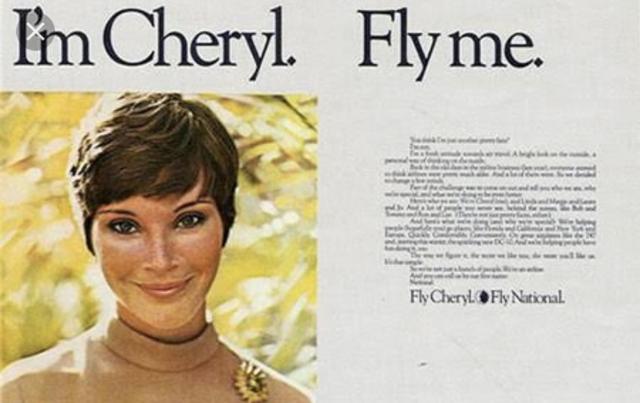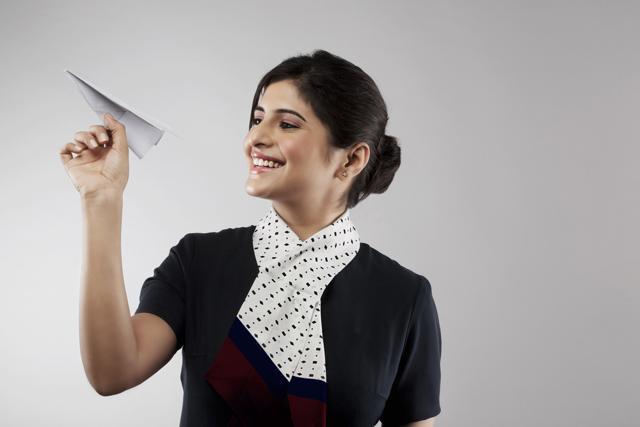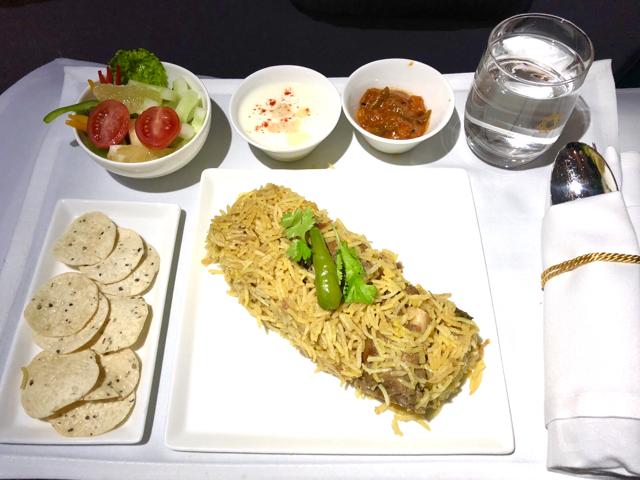Think of a reasonably high quality restaurant anywhere in the world. Now, think of the staff. The chances are that the majority (if not the vast majority) of the front-of-house staff, the servers, the managers etc. will be men. Sometimes, there may be an equal gender divide. But rare is the top restaurant where women staff-members outnumber the men.
Now, think of an airline cabin. Think of the cabin crew. The chances are that the women will outnumber (vastly outnumber, even) the men.
There has always been something inherently sexist about airline service. For a long time, all the pilots were men and the cabin crew were women Only occasionally, would there be a steward and he would be confined to the galley to do the heavy lifting, the heating of the meals, etc.
This is even more extraordinary when you consider that there were air hostesses in the sky decades ago, at a time when there were hardly any (none, perhaps) women servers at top restaurants.
Airlines have struggled to explain why this should be so. But none of their explanations makes sense. An airhostess’s job is physically demanding and strenuous. Hostesses are constantly on their feet, pushing trolleys or carrying trays. On long haul sectors, they are expected to be on duty for eight hours or more. (A restaurant service rarely takes more than four hours.) On a domestic sector, the crew will usually do two flights back to back. So, even in the old era of sexist job allocations, it seemed odd that women, who were regarded as ‘weaker’ than men, should be preferred for such a strenuous job.
The truth is that airlines wanted pretty girls on board to “enhance the inflight experience.” Most airlines chose their hostesses (either covertly or overtly) on the basis of appearance. In India, in the 1950s, when there were no female servers at top restaurants, Air-India made no secret of its focus on the looks of its air hostesses. In those days, Air-India hostesses were so famed for their beauty that they would be lent out to ad agencies for use as photographic models. (A tag line, below the photo, would usually read “Model Courtesy Air-India”.)
In the US, airlines based entire publicity campaigns on the sexiness of their hostesses. A famous campaign for National Airlines had a photo of a pretty girl with a slogan that used her name: “I am Cindy. Fly Me.” (Or Betty or Cathy or Jane or whatever). After protests erupted the airline reluctantly started putting men in the ads too. (“I am Jeff. Fly Me.”)

Asian airlines have nearly always made much of their hostesses. When Malaysia and Singapore ran an airline together the ad campaign focused on “Girl of MSA”. When Singapore started its own airline the campaign became “Singapore Girl.”
Earlier, Air-India had tried something similar, making a (very high quality) film called To Serve Is To Love which followed a group of attractive air hostesses as they travelled around the world. (The film was never widely shown but it is worth seeing today to recall an era when Air-India was regarded as glamorous.)
Over time, airlines have had to back away from the sexism of their cabin crew policies. Air-India used to insist that any hostess who got married had to quit. The Courts struck this down as discriminatory (which, of course, it was) and now hostesses retire at roughly the same time as their male counterparts.
This means that hostesses on older airlines like Air-India are not necessarily young and sylph-like any longer. This is as true of most US and European airlines. Fair enough; an aircraft cabin is not a catwalk. (And anyway, have you seen what the men look like?)
But we are so conditioned to require hostesses to look young and pretty that eight times out of ten, when someone is complaining about Air-India the appearance of the hostesses will come up.

In the late 1990s, I interviewed CM Ibrahim who was Civil Aviation Minister in the HD Deve Gowda government. Ibrahim, who was a bit of a rogue with the mindset of a sexist dinosaur, told me that he would transform the cabin crew in Air-India because “we want Miss India not Mother India.”
When the article appeared, a predictable and justified uproar ensued. The outraged women of Air-India insisted that the (mostly male) leaders of the Cabin Crew union go to see Ibrahim to register their protests.
A delegation duly met the minister and protested. But they were too gentle (and a little frightened) and framed their objections all wrong.
“Sir”, they began tentatively, “you have called our hostesses Mother India. But in our country, we respect our mothers....”
The old rogue was too sharp for them. “Yes I respect my mother too. I don’t tell her “mere liye whiskey lao.” You want me to demand things like that from Mother India? Have you no shame?” And so on.
The cabin crew delegation exited, tails between their legs and Ibrahim’s cheerful sexism reigned unabated.
At some level, many Indian men share Ibrahim’s prejudices. The newer airlines spend a lot of time and money on “perfecting” the appearance of their hostesses (the shoes, the hair, the idiotic wigs, the tight dresses etc.) and because none of the private airlines has been around as long as Air-India, their stewardesses tend to be younger.
I guess this matters to some passengers but most frequent travellers hardly notice what the air hostess looks like. They want efficiency and in the front of the aircraft, at least, they want the service to be personalised. There was a time when Air-India scored highly in the personalisation department but over time, alas, standards have dropped.
There are still many excellent members of the Air-India cabin crew team but at a time when everything else has gone wrong, it is too much to expect the cabin crew to make up for all the screw ups. On my last few Air-India international flights, the food has been terrible, the wines have been crap and on one flight, the crew could not even open the bottles because they did not have a corkscrew. The inflight entertainment system and the reading lights sometimes do not work and on one occasion, even the seat was broken.
Even the best cabin crew can’t make up for all these disasters. And because nothing else works, an international flight on Air-India depends too much on the calibre of the crew. (That said, I still fly Air-India to many destinations because I prefer it to most European and US airlines.)
The private airlines suffer from what I like to call the Call Centre problem. That is to say, the new generation of hostesses treats the job in the way that Call Centre employees regard their careers: okay for a couple of years but not a long-term option. So they do the bare minimum necessary to get by and they have no real commitment to the job or to the comfort of the passengers.

The only airlines I have found where the inflight service is consistently good both have a Singapore Airlines connection.
I flew the mother ship, the Singapore Airlines 340 to Singapore and back a month ago and was staggered by how terrific the inflight experience was. The standard jibe about SIA is that its staff work like robots without any emotion. In fact the opposite was true. Service was warm and personalised and every member of the crew went the extra mile.
My hand luggage, for instance, did not fit in the overhead locker so the hostess took it away to put in a cupboard somewhere else. This usually has nightmarish consequences because it takes ages to locate the bag when you land. But she remembered, without being asked, where it was and brought it to my seat as soon as we landed. My phone charger was not working. They managed to find a way of getting me to charge my phone. And so on.
The best domestic flight I have had in the last year or so also had a Singapore connection. I flew Vistara, which is part-owned by SIA, from Bangalore last week. I don’t normally eat on planes but this was a long flight (2 ½ hours) and Bangalore airport is a long way from my hotel (1½ hours). Add the time needed to check in and the drive back home in Delhi and I reckoned I would be without food for seven hours at dinner-time, which was way too long.
Because of my hatred of flight kitchen food, I asked my hotel to pack some biryani for me. When the Vistara hostess came to ask for my dinner order, I told her that I had brought my own food.
“Let me serve it to you,” she said and took away my little plastic container of biryani.
Ten minutes later, my dinner arrived. She had heated and plated my biryani so that it looked like a fancy restaurant dish. She had put salad, raita, papad and pickles on the tray without my asking for them. The biryani was very good anyway (Dum Pukht) but the service gave it the flourish of a gourmet experience.
No airline training programme teaches hostesses how to handle passengers who refuse to eat the inflight meal and bring their own food on board. What happened on that Vistara flight was an individual initiative, the result of one hostess’s commitment to making sure that a passenger had a memorable experience.
Ultimately that is the kind of service and commitment that makes passengers come back and fly the same airline again.

As it turned out, the Vistara hostess who served my meal was young and attractive. But contrary to what airlines think, that is not what I remember about her. For most frequent travellers, what matters is not what the hostess looks like but how well she does her job.
Personalisation, commitment to passenger comfort and a willingness to do more than is strictly necessary are the things that count.
High heels, tight skirts and wigs are just foolish, silly and irrelevant and at some level, demeaning to the women who do the serious and demanding job of inflight service.



